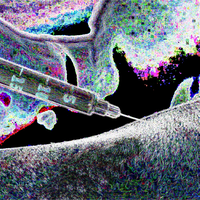| Oxycodone | |||
|---|---|---|---|
| Molecular structure via molpic based on CDK |
| Rotamer [] | |
|---|---|
| Conformer structure via 3Dmol.js |
| Physical properties [] | |
|---|---|
| Molecular mass | 315.4 g/mol [1] |
| Appearance | Rods from ethanol [1] |
| Melting point | 219 °C [1] |
| Decomposition | When heated to decomposition it emits toxic fumes of oxides of nitrogen. [1] |
| Solubility | 166mg/mL [1] |
| Predicted LogP | 1.2 [1] |
| Structural Identifiers [] | |
|---|---|
| Molecular formula | C18H21NO4 [1] |
| IUPAC name | (4R,4aS,7aR,12bS)-4a-hydroxy-9-methoxy-3-methyl-2,4,5,6,7a,13-hexahydro-1H-4,12-methanobenzofuro[3,2-e]isoquinolin-7-one [1] |
| SMILES | CN1CC[C@]23[C@@H]4C(=O)CC[C@]2([C@H]1CC5=C3C(=C(C=C5)OC)O4)O [1] |
| InChI | InChI=1S/C18H21NO4/c1-19-8-7-17-14-10-3-4-12(22-2)15(14)23-16(17)11(20)5-6-18(17,21)13(19)9-10/h3-4,13,16,21H,5-9H2,1-2H3/t13-,16+,17+,18-/m1/s1 [1] |
| InChIKey | BRUQQQPBMZOVGD-XFKAJCMBSA-N [1] |
| Dosing[] |
|---|
| Insufflated [] | |
|---|---|
| Threshold | 0.5 - 5 |
| Light | 5 - 10 |
| Common | 10 - 20 |
| Strong | 20 - 27.5 |
| Heavy | 27.5 - 40 |
| Oral [] | |
|---|---|
| Threshold | 0.5 - 2 |
| Light | 2 - 5 |
| Common | 5 - 11.25 |
| Strong | 11.25 - 20 |
| Heavy | 20 - 40 |
Statistically derived dosages via DBI-IGS We do not take any responsibility for medical complications or loss of life sustained by following these dosages blindly. |
Oxycodone
Oxycodone (also known as Dihydrone, Dihydrohydroxycodeinone, Oxycodeinone, Dihydroxycodeinone, Oxicon, Diphydrone, Eucodalum, Oxycodon, Percobarb or Oxicodona) is a
Chemistry
Salts []
Oxycodone is typically found in the form of its phosphate and hydrochloride salts.
Stereochemistry []
Oxycodone is a absolute mixture
| Anodyne Usernotes [] | |||
|---|---|---|---|
| magnus / Oxycodone via Oral |
0xea / Oxycodone via Oral and Intravenous | | |
 Anodyne
Anodyne